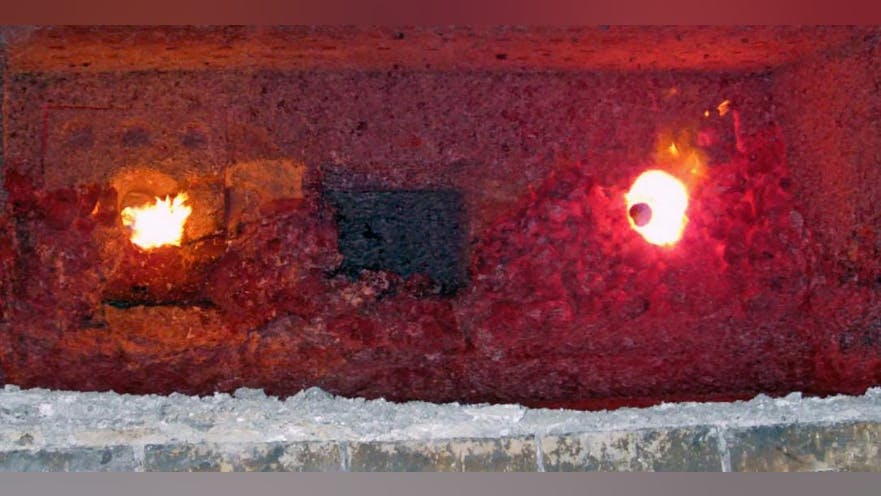Aluminum melting operations are constantly challenged to keep their process equipment performing effectively. Due to robust demand, foundries and diecasters often operate furnaces at higher temperatures to maximize production rates. As a result, one of the costliest operational challenges is heavy aluminum oxide (Al2O3, or corundum) formation in those furnaces.
Damaging and costly corundum growth can be mitigated with the right refractory materials, coupled with the correct maintenance and watchful operation.
Root causes — Corundum growth in a refractory lining of an aluminum furnace occurs due to a reaction between the alumina-silicate refractory and molten aluminum. Al2O3 formation can occur both externally and internally in the refractory lining, and there are four identifiable root causes that promote corundum growth: high temperatures; the presence of oxygen; alloy composition; and the use of fluxes and fluoride salts.
High temperatures accelerate the reduction of oxides in the refractory. As temperatures rise, non-wetting agents will lose their effectiveness. Aluminum begins to penetrate the refractory matrix because of decreases in aluminum viscosity and surface tension. Excessive furnace temperature can be the result of several causes, including overfiring, improper furnace control, or inaccurate thermocouple placement. For example, a thermocouple that is recessed into the refractory lining by 2 inches may underreport temperatures by several hundred degrees.
Oxygen drives the reaction process in two ways: as an atmospheric gas, and as a reducible oxide in the refractory. Minimizing oxygen by controlling negative pressure sources, such as doors, windows, and well openings, reduces the potential for reaction. Proper flue sizing and burner stoichiometry also reduce excess oxygen and improve furnace energy efficiency.
Alloy composition can be a factor. Some aluminum alloys contain elements that reduce the silica as well as iron oxide, zinc oxide, and other oxides in refractories. Careful attention is necessary in choosing an appropriate refractory for more aggressive aluminum alloys to reduce the potential for reaction.
Use of fluxes and fluoride salts like cryolite Na3AlF6 in aluminum melting accelerate the reduction of oxides in the refractory. Their alkaline properties also reduce the local melt temperature of the refractory at the bellyband and then infiltrate the furnace lining. Over time, with lack of regular maintenance, the corundum buildup will reduce furnace performance and increase aluminum loss.
Trouble spots — Corundum growth occurs most commonly where its formation mechanisms of heat and oxygen are present. Typical problem areas include doors, openings, flue areas, and burner cones due to the potential for excess oxygen. Negative furnace pressure also can also to leakage from the outside. Other common areas of formation include rear walls and bellyband areas where regular cleaning and maintenance are more difficult.
Control and avoidance — Fighting corundum starts with choosing the proper refractory material for molten aluminum contact. Plibrico pioneered development of effective refractory additives that combat corundum, including non-wetting additives, dense oxide-barrier formers, and pore-size reducers. These additives can be found in:
• Plicast Al-Tuff®, a system that increases wetting resistance and reduces the potential for oxidation-reduction of the refractory;
• Plibrico’s Al-Shield™, refractories that form a reactive layer to resist molten aluminum penetration up to 2,000°F;
• Phos-bonded castables like Plibrico’s Exo-set Uno™ offer good resistance to metal slag penetration, especially in higher temperatures, and adhere well to the existing refractory for repairs
In general, PliPartner refractory contractors find phos-bonded plastic refractories to be excellent repair materials for aluminum processors. Usually they are low in free silica and nonwetting. The material bonds chemically to existing refractory, making it easier to install, and phos-bonded plastic refractories are an excellent solution for corundum growth at the bellyband.
Best practices — A regular maintenance plan can increase refractory life; a schedule is essential. A knowledgeable refractory expert with aluminum melting experience can help determine schedules and checklists.
Corundum buildup is a common concern for aluminum furnace operators. Optimal longevity for a furnace lining depends on best practices in refractory materials and installation methods, knowing the past refractory performance to evaluate future performance, managing expectations of furnace output, and monitoring regular maintenance and operation of the furnace.
These are measurable key performance indicators that will help decision-makers design and build good refractory linings for the demanding needs of aluminum producers today. Considering these factors and balancing them according to the producers’ needs can deliver a higher-quality product for longer life.
Plibrico Co. LLC is a supplier of alumino-silicate and high-alumina monolithic refractories. Learn more at www.plibrico.com









